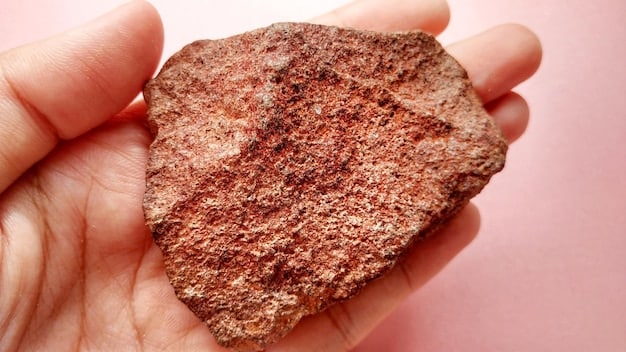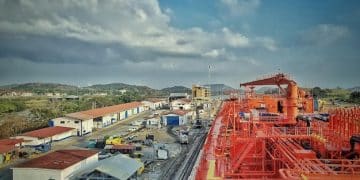Peru’s Copper Boom: Impacts on the US Market & Consumers

Peru’s increasing copper production significantly influences the global market, affecting US consumers through prices of electronics, vehicles, and construction materials, while also raising concerns about environmental impacts and supply chain stability.
Peru’s rise as a major copper producer has far-reaching implications, especially for US consumers who rely on this essential metal for various goods. The increasing supply from Peru can influence prices, supply chains, and even the environmental considerations associated with copper mining. Understanding **the impact of Peru’s increased copper production on the global market and US consumers** is crucial in today’s interconnected economy.
Peru’s Ascendancy in the Global Copper Market
Peru has emerged as a significant player in the global copper market, challenging established producers and reshaping supply dynamics. Its strategic location, rich mineral resources, and favorable investment climate have propelled its copper industry forward.
Key Factors Driving Peru’s Copper Production
Several factors have contributed to Peru’s success in increasing its copper output, including favorable geological conditions and sustained investment in mining infrastructure.
- Abundant Copper Reserves: Peru boasts some of the world’s largest copper reserves, making it an attractive destination for mining companies.
- Government Support: The Peruvian government has implemented policies to encourage foreign investment in the mining sector.
- Technological Advancements: The adoption of modern mining techniques has improved efficiency and increased production capacity.
Peru’s growing copper production has not only boosted its own economy but also has had cascading effects on the global market, especially for consumers in the US who depend on copper for numerous applications.

The Influence of Peruvian Copper on Global Copper Prices
Peru’s increased copper production directly impacts global copper prices, creating ripple effects throughout industries that rely on this critical metal. As supply from Peru increases, it exerts downward pressure on prices, affecting various sectors.
Supply and Demand Dynamics
The relationship between supply and demand dictates the price of copper globally. Peru’s rise in copper production has shifted this balance.
With Peru contributing a larger share of the global copper supply, there’s increased availability, potentially lowering prices. These dynamics are closely monitored by consumers and sectors in the US.
Impact on US Industries
The impact of the increased copper production on prices is felt in several key sectors in the US. The construction, electronics, and automotive industries, all heavily reliant on copper, experience this impact.
- Construction: Lower copper prices can reduce the cost of wiring, plumbing, and other copper-dependent materials.
- Electronics: Consumers may benefit from more affordable electronic devices due to decreased manufacturing costs.
- Automotive: Both traditional and electric vehicles utilize copper extensively, so the impact is felt in manufacturing costs.
Peru’s influence on global copper prices is a complex interplay of factors that ultimately have tangible effects on US consumers and industries.
How Peruvian Copper Reaches US Consumers
The journey of Peruvian copper from the mine to the hands of US consumers involves a sophisticated network of trade, processing, and manufacturing. Understanding this supply chain highlights the interconnectedness of global economies.
The Supply Chain Process
The supply chain begins with the extraction of copper ore in Peru which is then processed and transformed into refined copper products.
These products are then shipped to various destinations, including the US, where they are used in manufacturing processes. The integration of Peruvian copper into the US supply chain reflects the reliance on global resources.
Major Industries Using Peruvian Copper in the US
Several industries in the US rely heavily on Peruvian copper to support their manufacturing operations. These industries range from construction to technology.
- Electronics Manufacturing: Copper is an essential component in printed circuit boards, wiring, and connectors.
- Automotive Production: Copper is used in wiring harnesses, motors, and braking systems in both traditional and electric vehicles.
- Construction Sector: Copper is used in electrical wiring, plumbing pipes, and roofing materials.
The US industries that use Peruvian copper are integral to the economy, so, the efficiency and reliability of the supply chain are paramount.

Environmental and Social Considerations
While Peru’s increased copper production brings economic benefits, it also raises important environmental and social concerns. These considerations are relevant to US consumers who are increasingly conscious of sustainable practices.
Environmental Impact of Copper Mining in Peru
Copper mining can have significant environmental consequences, which can, in turn, impact local communities and ecosystems.
Deforestation, water pollution, and habitat destruction are potential side effects of mining activities. There is an increasing need for sustainable environmental practices to reduce these effects.
Social Responsibility and Community Engagement
Mining companies have a significant social responsibility to engage with and support local communities. The relationships between firms and residents plays a crucial role in economic development.
- Community Development Programs: Mining companies need to invest in education, healthcare, and infrastructure to improve the quality of life in local communities.
- Fair Labor Practices: Ensuring safe working conditions and fair wages for mine workers ensures a stable labor market.
- Environmental Stewardship: Companies must adopt practices that reduce the environmental impact of mining operations.
The responsible mining of copper in Peru is not just an environmental issue; it is a social imperative that affects the well-being of communities and the long-term sustainability of the industry.
Potential Future Trends and Impacts
Looking ahead, several trends could shape the future of Peru’s copper production and its impact on the global market and US consumers. These trends encompass technological advancements, policy changes, and market dynamics.
Technological Advancements in Copper Mining
Technological innovations could revolutionize copper mining, making it more efficient and environmentally friendly by reducing the environmental impact.
Automation, digitalization, and advanced extraction techniques hold the potential to enhance productivity. These advancements would contribute to more sustainable and cost-effective production.
Policy and Regulatory Changes
Government policies and regulations play a crucial role in shaping the copper industry. Changes in policy can influence investment, production, and trade.
- Environmental Regulations: Stricter environmental standards can promote sustainability but may also increase operating costs.
- Trade Policies: Trade agreements can impact the flow of copper between Peru and the US, affecting supply dynamics.
- Tax Incentives: Tax breaks can encourage investment in new mining projects, boosting overall production.
Geopolitical Factors Affecting Copper Trade
Geopolitical factors could play a part in copper, impacting its trade and international relations. Instability may cause a disruption in the flow of metals to the US.
Trade disputes between countries could affect supply chains and prices. Maintaining stable relationships ensures the smooth movement of copper.
| Key Aspect | Brief Description |
|---|---|
| 📈 Production Growth | Peru’s copper output is increasing, impacting global metal supply. |
| 💰 Price Influence | Increased output from Peru can moderate global copper prices. |
| 🌎 Supply Chains | Impacts industries: electronics, automotive. |
| 🌱 Sustainability | Environmental impacts of mining are growing in global importance. |
Frequently Asked Questions
▼
Peru possesses abundant copper reserves, favorable investment policies, and geological conditions. This convergence factors allows mining operations to thrive in the country, boosting national output over time.
▼
Copper from Peru finds its way into US electronics manufacturing. It is essential in printed circuit boards, wiring, and connectors, ensuring more affordable devices by helping in cost reduction.
▼
Copper mining in Peru is often associated with water contamination, deforestation and habitat destruction. The social and environmental responsibility of the mining company is important to the sustainability of the product.
▼
Mining can affect local groups with issues such as displacement and labor standards. Mining operations can partner with the people through community program and fair labor practices to offset damage.
▼
The stability of US and Peru relies on stable trade relations, transparent policies, and environmental stewardship. Sustained collaboration boosts resilience, allowing the flow of copper which is critical to several US industries.
Conclusion
Peru’s growing prominence in the global copper market has profound implications for US consumers. As Peru increases its copper production, it influences global prices, affects supply chains, and presents environmental and social considerations. By staying informed about these dynamics, consumers and policymakers can make better decisions that foster a more sustainable and prosperous future with benefits for all.





